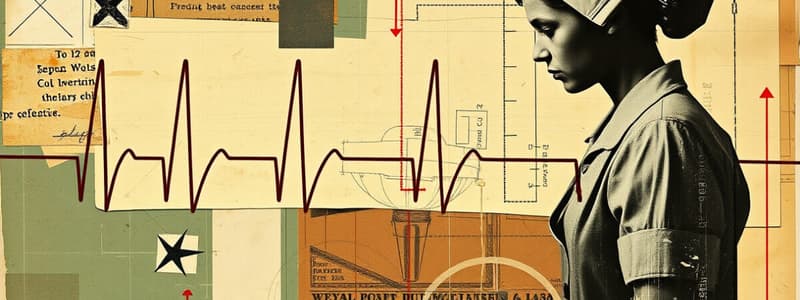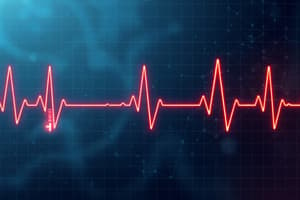Podcast
Questions and Answers
What is the primary difference between pulse rate and heart rate?
What is the primary difference between pulse rate and heart rate?
- Pulse rate includes both heartbeats and blood flow, while heart rate is only concerned with heartbeats.
- Pulse rate refers to the heart's contraction, while heart rate measures blood flow.
- Pulse rate measures the number of times blood can be felt at an artery, while heart rate measures heartbeats. (correct)
- There is no significant difference; both terms are interchangeable.
What defines stroke volume?
What defines stroke volume?
- The total volume of blood pumped in one minute by the heart.
- The volume of blood present in the arteries at any time.
- The amount of blood ejected with each heartbeat. (correct)
- The frequency of heartbeats in one minute.
In what situation should pulse assessments be prioritized according to nursing judgment?
In what situation should pulse assessments be prioritized according to nursing judgment?
- Routine checks at predetermined intervals regardless of patient condition.
- Whenever the patient reports feeling fatigued.
- When there is an alteration in patient status or pulse character. (correct)
- Only during medical emergencies as directed by a physician.
What physiological event is associated with pulse creation?
What physiological event is associated with pulse creation?
Cardiac Output is calculated as which of the following?
Cardiac Output is calculated as which of the following?
Where should the femoral pulse be palpated?
Where should the femoral pulse be palpated?
What is the purpose of assessing peripheral lower extremity pulses?
What is the purpose of assessing peripheral lower extremity pulses?
What additional equipment is used to assess the apical pulse?
What additional equipment is used to assess the apical pulse?
Which anatomical landmark corresponds to the aortic auscultory site?
Which anatomical landmark corresponds to the aortic auscultory site?
What type of sounds is best assessed with the diaphragm of a stethoscope?
What type of sounds is best assessed with the diaphragm of a stethoscope?
Where is the apical pulse typically located?
Where is the apical pulse typically located?
What characterizes the S1 heart sound?
What characterizes the S1 heart sound?
How should one assess the quality of a pulse?
How should one assess the quality of a pulse?
What does a bounding pulse indicate?
What does a bounding pulse indicate?
What is the purpose of using a Doppler device in pulse assessment?
What is the purpose of using a Doppler device in pulse assessment?
What is the normal pulse rate range for adult patients?
What is the normal pulse rate range for adult patients?
Which pulse rate condition indicates tachycardia?
Which pulse rate condition indicates tachycardia?
What are common causes of bradycardia?
What are common causes of bradycardia?
Which pulse site is most commonly used for routine vital signs?
Which pulse site is most commonly used for routine vital signs?
In older adults, what physiological change may affect the assessment of pulse?
In older adults, what physiological change may affect the assessment of pulse?
What is the correct approach for counting an irregular radial pulse?
What is the correct approach for counting an irregular radial pulse?
Which pulse site is suggested for emergency situations?
Which pulse site is suggested for emergency situations?
What should be avoided when locating the radial pulse?
What should be avoided when locating the radial pulse?
Flashcards are hidden until you start studying
Study Notes
Vital Signs: Pulse Measurement
-
Pulse Definition: Palpable blood flow sensed at various body points.
-
Key Terms:
- Pulse Rate: Number of pulse sensations per minute.
- Heart Rate: Number of heartbeats per minute.
- Stroke Volume: Blood ejected per ventricular contraction (60-70 ml).
- Cardiac Output: Blood volume pumped per minute (Heart Rate x Stroke Volume).
Physiology and Regulation
- Each ejection of stroke volume distends aorta walls, creating a pulse wave.
- The pulse wave travels to peripheral arteries, allowing pulse palpation over bony or muscular areas.
When to Assess Pulses
- Based on physician's orders and nursing judgment.
- Consider alterations in pulse rate, patient status, and influencing factors such as activity, pathology, medications, and prior readings.
Adult Pulse Rate Variables
- Normal pulse rate: 60-100 beats per minute.
- Tachycardia: Rate > 100, caused by factors like emotions, exercise, fever.
- Bradycardia: Rate < 60, associated with medications and physical conditioning.
Pulse Variations in Older Adults
- Normal pulse rate: 60-100 but may be irregular due to health conditions.
- Palpation may be difficult due to decreased elasticity and atherosclerosis.
- Slower sympathetic nervous response affects pulse reactivity.
Pulse Sites
- Radial and Apical: Most common for routine checks.
- Carotid: Used in emergencies; easily accessible.
- Brachial: Ideal for blood pressure readings, especially in infants.
- Femoral, Popliteal, Posterior Tibial, Dorsalis Pedis: Assess peripheral pulses in lower extremities.
Assessing Pulses: Radial
- Use 2-3 fingertips to locate the pulse, apply moderate pressure, avoid using the thumb.
- Count for 30 seconds if the rhythm is regular or for 60 seconds if irregular.
Assessing Pulses: Other Sites
- Brachial: Located on the ulnar side of the arm at the antecubital space.
- Carotid: Palpate at the medial edge of the sternocleidomastoid muscle; do one side at a time.
- Femoral: Found at the midline of the groin fold.
Apical Pulse Assessment
- Auscultate using a stethoscope positioned correctly to listen for heartbeats.
- Diaphragm of the stethoscope is for high-pitched sounds; bell for low-pitched sounds.
Anatomical Landmarks for Auscultation
- Aortic: 2nd intercostal space, right sternal border.
- Pulmonic: 2nd intercostal space, left sternal border.
- Tricuspid: 4th or 5th intercostal space, left sternal border.
- Mitral: 5th intercostal space, left mid-clavicular line.
Heart Sounds
- S1 ("Lub"): Low-pitched sound from closure of mitral/tricuspid valves; best heard at the apex.
- S2 ("Dub"): High-pitched sound from closure of pulmonic/aortic valves; best heard at the base.
Counting an Apical Pulse
- Use a clean stethoscope; ensure warmth and cleanliness.
- Locate the heart's apex; count for a full 60 seconds, noting rhythm and strength.
Assessing Quality of Pulses
- Strength: Reflects pulse force or intensity.
- Normal: Full, moderate pressure required.
- Bounding: Forceful, hard to obliterate.
- Weak/"Thready": Easy to obliterate, poor circulation.
- Equality: Assess if pulse strength/rate is equal bilaterally.
Using a Doppler
- An electronic device amplifying pulse sounds, helpful for inaudible pulses.
- Apply gel for optimal contact; movement over the pulse area produces a swooshing sound indicating the pulse is audible.
Studying That Suits You
Use AI to generate personalized quizzes and flashcards to suit your learning preferences.




